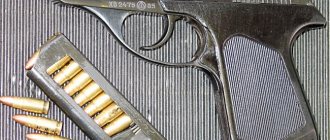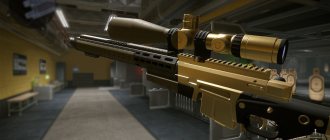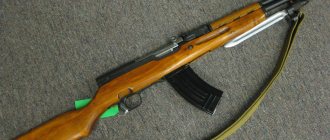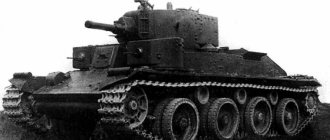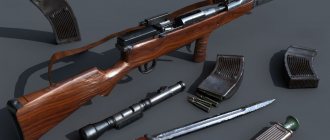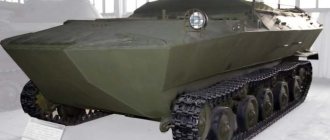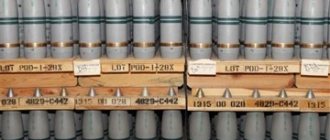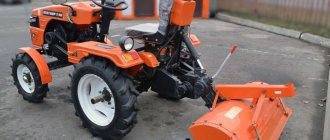Mauser 98k
The main weapon of the German infantry.
A German-made repeating rifle that entered service in 1935. In the Wehrmacht troops, this weapon was one of the most common and popular. In a number of parameters, the Mauser 98k was superior to the Soviet Mosin rifle. In particular, the Mauser weighed less, was shorter, had a more reliable bolt and a rate of fire of 15 rounds per minute, versus 10 for the Mosin rifle. The German counterpart paid for all this with a shorter firing range and weaker stopping power.
Small arms of the USSR: on the way to automatic weapons
By the 30s of the 20th century, world military thought had finally and irrevocably established itself in the idea that a lot of troops is, of course, good, but it’s even better if this mass of troops fires as many bullets as possible per 1 km. front. Moreover, the struggle for rate of fire began even earlier. In the Middle Ages, there were peculiar “machine gunners” - English yeomen who could fire arrows with amazing speed, the same can be said about the Mongolian horse archers. If we talk directly about small arms, then by 1910, almost all the leading designers in the world came to the conclusion that it was necessary to develop self-loading automatic rifles.
This trend did not bypass Russia, where work on the development of automatic systems was carried out by many designers, but the most successful of them was Vladimir Grigorievich Fedorov. Fedorov came from an ordinary teacher’s family, but fate prepared for him a rather interesting path in life. Vladimir Fedorov was the recipient of many awards from both the Russian Empire and the USSR, including the unique title “Hero of Labor” - the predecessor of the Hero of Socialist Labor award; he managed to rise to the rank of lieutenant general of the Red Army.
Fedorov assault rifle
Fedorov designed his assault rifle while a captain in the Russian Imperial Army in 1913-1916. And he began his first work on a self-loading rifle back in 1906. His first rifle was developed for the standard cartridge of the famous Russian three-line 7.62x54R and was equipped with an integral magazine with a capacity of 5 rounds. It was tested in 1911, and in 1912 the Artillery Committee even approved its release, ordering 150 copies for military testing. At the same time, the designer was working on creating a cartridge that would initially be suitable for automatic weapons. In 1913, he proposed a project for an automatic rifle (the term “automatic” was introduced later, only in the 1920s) chambered for a new cartridge of his own design.
Vladimir Fedorov's cartridge had a pointed bullet of 6.5 mm caliber and a mass of 8.5 g. The initial speed of this bullet was approximately 850 m/s, and the muzzle energy was 3100 Joules. At the same time, the standard Russian rifle and machine gun cartridge 7.62x54R, depending on the equipment version, had a muzzle energy of about 3600-4000 Joules. At the same time, Fedorov’s 6.5 mm cartridge gave a weaker recoil impulse compared to the standard 7.62x54R cartridge and had less mass.
All these qualities, along with lower muzzle energy and the design of the cartridge case without a protruding rim, made Vladimir Fedorov’s cartridge better suited for automatic weapons, allowing it to be reliably fed from large-capacity magazines. Testing of the new product began in 1913, but the outbreak of the First World War made its own adjustments. By 1915, the Russian Imperial Army was experiencing an acute shortage of small arms. This was especially true for light machine guns. As a result, new Fedorov automatic rifles were ordered as light weapons to support infantry units, but chambered for the Japanese 6.5x50SR Arisaka rifle cartridge.
It had similar characteristics to the Fedorov cartridge, and at the same time there were a sufficient number of them in Russia, since Japanese cartridges at the very beginning of the First World War were bought along with Arisaka rifles in order to make up for the army’s losses in small arms. Already produced Fedorov automatic rifles chambered for the Japanese cartridge were converted by installing a special insert in the chamber. It should be noted that both the cartridge for the Arisaka rifle and the Fedorov cartridge were typical rifle cartridges in their ballistic characteristics, although they were distinguished by a smaller caliber and, accordingly, power. They were not an intermediate development, as claimed in a number of sources.
By the summer of 1916, experimental Fedorov assault rifles had undergone a series of military tests in a special company, after which it was decided to equip the team of the 189th Izmail Regiment (158 soldiers and 4 officers) with them, which departed for the Romanian Front on December 1, 1916. The decision to serially produce the “2.5-line Fedorov rifle” was made; they were to be produced at the Sestroretsk Arms Plant. However, in the conditions of a large-scale war, this enterprise could not cope even with the production of its main products (rifles model 1891/10), so mass production of the Fedorov automatic rifle was not established.
It began to be mass-produced only after the revolution at the Kovrov plant (today it is the Degtyarev plant). At the same time, the order was reduced from 15,000 to 9,000 units. Until 1924, when production of the Fedorov assault rifle was stopped, only 3,200 units of this small arms were collected. In 1923, it was modernized; the weapon received a new firing mechanism, sight and magazine. Fedorov assault rifles continued to be in service with the Red Army until 1928. Afterwards, it was decided to remove them from service due to the unification of the cartridges used. All the machine guns were transferred to warehouses, but were still useful to the military. In 1940 they were used in Karelia during the Winter War with Finland.
It should be noted that Fedorov’s development could not be used as a mass-produced army small weapon, since it did not ensure reliable operation in complex and difficult operating conditions. In addition, this machine was quite difficult to maintain and manufacture. An analysis of the only reliable source on the operation of the machine gun available at the moment - a brochure from 1923 - demonstrates that the main problem of the Fedorov machine gun was not so much the design flaws as such, but the low quality of the construction materials used - metal deposits, sediment of parts, etc. , as well as the low quality of ammunition that was supplied to the troops. At the same time, the Fedorov assault rifle was the first working model of an individual automatic weapon, which, moreover, was used in battle, which is the main merit of this assault rifle, as well as its designer.
Tokarev self-loading rifles - SVT38/40
The first example of individual automatic small arms, which was created and adopted for service in the Soviet Union, was the automatic rifle designed by Simonov - ABC. In competition with another famous Soviet weapons designer, Fedor Vasilyevich Tokarev, Sergei Gavrilovich Simonov developed a weapon that was adopted by the Red Army in 1936, and already in 1938, all infantrymen of the 1st Moscow Rifle Division were armed with the ABC-36. In 1939, ABC-36 was able to receive its first baptism of fire during the war with Finland. However, the main method of firing from the ABC was firing single cartridges; firing in bursts was possible, but only in emergency cases.
On July 17, 1939, guided by the desire to rearm the Red Army with self-loading rifles as soon as possible, the Defense Committee, on the personal instructions of Stalin, decided to concentrate all the efforts of the People's Commissariat of Armaments on another self-loading rifle - the SVT-38. It also played a role that Stalin knew Tokarev quite well, and the name Simonov meant little to him.
The SVT was adopted by the Red Army back in 1938 and received the designation SVT-38; in 1940, a slightly lighter version of the rifle was adopted for service, which received the designation SVT-40; production of the rifle continued until 1945, and in the first half of the war at an increasing pace , and then in smaller and smaller quantities. In total, up to 1.5 million of these rifles were produced, including up to 50 thousand SVT-40, made in the sniper version.
The troops nicknamed this rifle “Svetka”. The rifle was used during the Soviet-Finnish War, as well as during the Great Patriotic War. In a number of units of the Red Army it was the main weapon, but in most cases only part of the infantrymen were armed with it. The general opinion about SVT was quite controversial. On the one hand, in the Red Army the SVT-40 earned a reputation as not the most reliable small arms, which were sensitive to frost and dirt. On the other hand, this rifle enjoyed well-deserved love and popularity among many infantrymen, since it was significantly superior to the Mosin rifle in firepower.
The captured SVT-38/40 was highly valued by German and Finnish soldiers; the Germans even adopted them as small arms of a limited standard. The American military also spoke quite well about the SVT. All this can be explained primarily by the fact that the training of the bulk of the infantrymen in the Red Army was at a low level, as well as the low level of maintenance of small arms in front-line conditions (the use of unsuitable or low-quality lubricants), as well as the massive use of American gunpowder in cartridges (supplied to the USSR under Lend-Lease), which produced a lot of soot. It is worth noting that 20 years later, similar problems began to plague the young American M16 automatic rifle during the Vietnam War, which, however, did not prevent it from becoming one of the best small arms in its class.
Many units, as well as individual soldiers of the Red Army who had a sufficient level of training, for example the Marine Corps, used SVT quite successfully until the end of the war. At the same time, the sniper version of the SVT-40 was inferior in effective range and accuracy to the Mosin sniper rifle mod. 1891/30, so by the middle of the Great Patriotic War it was replaced in production by the less rapid-fire and outdated, but more accurate Mosinka.
The SVT-40, as its name suggests, was a self-loading (semi-automatic) weapon. The rifle worked on the principle of removing gases from the barrel bore and had a short stroke of the gas piston. The barrel is locked by tilting the bolt in a vertical plane. The rifle had a composite wooden stock. The trigger mechanism is trigger. The SVT-40 was equipped with a box-shaped, double-row, detachable magazine for 10 rounds. It was possible to equip magazines both separately from the rifle and in an attached state using standard 5-round clips for the Mosin rifle. The sights are open, consisting of a front sight with a muffler and a rear sight, which could be adjusted in range. The rifle had a muzzle brake and a gas regulator, which made it possible to change the amount of gases discharged from its barrel. Additionally, it was equipped with a bayonet-knife, which could be attached to the rifle if necessary.
The SVT-38/40 was not inferior to the American M1 Garand self-loading rifle and was clearly superior to the later German models G.41(M) and G.41(W). A significant number of automatic rifles among Soviet riflemen (about 1 million SVTs were produced before the war) came as a surprise to German soldiers at the beginning of the war. In the summer of 1941, a German soldier wrote in a letter home: “The Russians are completely armed with light machine guns.” The famous commander of the 2nd Panzer Army, Heinz Guderian, in his report on the experience of fighting in the Eastern Freon on November 7, 1941, wrote: “Its (Soviet infantry) weapons are inferior to the German ones, with the exception of the automatic rifle.”
However, for all the usefulness of automatic and self-loading rifles, in a large-scale war they had one serious drawback that negated all their advantages. All of them were distinguished by technical complexity, which was beyond the control of the large number of recruits who entered the troops, one might say “from the plow”. At the same time, in capable hands, the SVT was a very formidable weapon. And for the mass saturation of “bullets per kilometer of the front” during combat operations, other types of automatic weapons were used - submachine guns (PPSh, PPS).
Sources of information: -https://voennovosti.ru/2013/08/strelkovoe-oruzhie-rossii-era-avtomatiki -https://www.armoury-online.ru/articles/ar/ru/Fedorov -https:// world.guns.ru/rifle/autoloading-rifles/rus/tokarev-svt-3-svt-40-r.html -https://ru.wikipedia.org
Luger pistol
Austrian pistol.
This 9mm pistol was designed by Georg Luger back in 1900. Modern experts consider this pistol to be the best during the Second World War. The design of the Luger was very reliable, it had an energy-efficient design, low accuracy of fire, high accuracy and rate of fire. The only significant flaw of this weapon was the inability to close the locking levers with the structure, as a result of which the Luger could become clogged with dirt and stop shooting.
MP 38/40
The same submachine gun.
Thanks to Soviet and Russian cinema, this “Maschinenpistole” became one of the symbols of the Nazi war machine. The reality, as always, is much less poetic. The MP 38/40, popular in media culture, has never been the main small arms for most Wehrmacht units. They armed them with drivers, tank crews, special forces detachments, rear guard detachments, as well as junior officers of the ground forces. The German infantry was mostly armed with Mauser 98k. Only occasionally MP 38/40s were handed over to assault troops in some quantity as “additional” weapons.
FG-42
An elegant hybrid weapon.
The German semi-automatic rifle FG-42 was intended for paratroopers. It is believed that the impetus for the creation of this rifle was Operation Mercury to capture the island of Crete. Due to the specifics of parachutes, the Wehrmacht landing force carried only light weapons. All heavy and auxiliary weapons were dropped separately in special containers. This approach caused large losses on the part of the landing force. The FG-42 rifle was a fairly good solution. I used 7.92×57 mm caliber cartridges, which fit into 10-20 magazines.
Lee Enfield
The British Lee-Enfield No. 4 MK became the main infantry rifle of the British and Allied armies. By 1941, when mass production and use of the Lee-Enfield began, the rifle had undergone a number of changes and modifications to the bolt action mechanism, the original version of which was created back in 1895. Some units (such as the Bangladesh Police) still use the Lee-Enfield, making it the only bolt action rifle in service for such a long time. In total, there are 17 million Lee-Enfield products of various series and modifications.
The Lee-Enfield has a similar rate of fire to the Em-One Garand. The sighting slit of the sight was designed in such a way that the projectile could hit the target from a distance of 180-1200 meters, which significantly increased the firing range and accuracy. Lee-Enfield fired 303 British cartridges with a caliber of 7.9 mm and fired up to 10 shots at a time in two bursts of 5 rounds.
MG 42
The most famous Wehrmacht machine gun.
During World War II, Germany used many different machine guns, but it was the MG 42 that became one of the symbols of the aggressor in the yard with the MP 38/40 submachine gun. This machine gun was created in 1942 and partially replaced the not very reliable MG 34. Despite the fact that the new machine gun was incredibly effective, it had two important drawbacks. Firstly, the MG 42 was very sensitive to contamination. Secondly, it had an expensive and labor-intensive production technology.
Gewehr 43
German answer.
Before the start of World War II, the Wehrmacht command was least interested in the possibility of using self-loading rifles. It was believed that the infantry should be armed with conventional rifles, and have light machine guns for support. Everything changed in 1941 with the outbreak of war. The Gewehr 43 semi-automatic rifle is one of the best in its class, second only to its Soviet and American counterparts. Its qualities are very similar to the domestic SVT-40. There was also a sniper version of this weapon.
Solar weapons
All previous versions of innovations have prototypes, are accompanied by documentation (albeit fragmentary), and some have been observed in real life. However, there are Nazi developments about which there are only scientific rumors and passing mentions. One of them is “Solar Weapon”. His idea originated back in 1929, with a German physicist named Herbert Oberth. Its meaning lies in the construction of an installation in Earth’s orbit that is capable of concentrating the energy of our star and redirecting it in a narrow beam to a certain point on the planet.
It’s good that Nazi Germany had neither the resources nor the ability to implement this idea. However, experts recognize it as one of the most successful. Simply ahead of its time by at least a century. But rather – one and a half to two.
StG 44
Revolutionary of the genre.
The Sturmgewehr 44 assault rifle was not the best weapon during World War II. It was heavy, completely uncomfortable, and difficult to maintain. Despite all these flaws, the StG 44 became the first modern type assault rifle. As you can easily guess from the name, it was produced already in 1944, and although this rifle could not save the Wehrmacht from defeat, it brought about a revolution in the field of handguns.
Stielhandgranate
Safe but unreliable grenade.
Another “symbol” of the Wehrmacht. This anti-personnel hand grenade was widely used by German troops in World War II. It was a favorite trophy of soldiers of the anti-Hitler coalition on all fronts, due to its safety and convenience. At the time of the 40s of the 20th century, Stielhandgranate was almost the only grenade completely protected from arbitrary detonation. However, it also had a number of disadvantages. For example, these grenades could not be stored in a warehouse for a long time. They also often leaked, which led to wetness and damage to the explosive.
Faustpatrone
A fundamentally new type of weapon, in its time.
The first single-action anti-tank grenade launcher in human history. In the Soviet army, the name “Faustpatron” was later assigned to all German anti-tank grenade launchers. The weapon was created in 1942 specifically “for” the Eastern Front. The thing is that German soldiers at that time were completely deprived of the means of close combat with Soviet light and medium tanks.
Opinion
The main question can be formulated as follows: could the German “miracle weapon” have had a significant impact on the course of the war and tipped the scales towards the Third Reich? The famous historian, author of many works on the topic of the First and Second World Wars, Yuri Bakhurin, responded to us:
“A “miracle weapon” could hardly have changed the course of World War II, and here’s why. Already due to the complexity of the design of most of these projects, in conditions of limited resources, Nazi Germany did not have the opportunity to establish mass production of one or another “weapon of retaliation.” In any case, its individual samples would have been powerless against the total power of the Red Army and the forces of the Allies. Not to mention the fact that many Wunderwaffe projects were technologically dead-ends.
Among armored vehicles, the most expressive examples of this are the super-heavy “rodents” - the “Mouse” and “Rat” tanks. The first, after being embodied in metal, the Germans could not even evacuate when the Red Army troops approached. The second, with a projected mass of up to 1000 tons, turned out to be stillborn - it did not come to the assembly of the prototype. The search for the “wunderwaffe” was a unique form of military-technical escapism for Germany. Accordingly, he would not have been able to bring the Reich, which was losing the war, out of the crisis at the front, in industry, etc.
PzB 38
Didn't bite through the armor of Soviet tanks.
The German anti-tank rifle Panzerbüchse Modell 1938 is one of the most little-known types of small arms from the Second World War. The thing is that it was discontinued in 1942, as it turned out to be extremely ineffective against Soviet medium tanks. However, this weapon is confirmation that it was not only the Red Army that used such guns.
Source
Tanks
The first association when hearing the word Wehrmacht is the clang of steel tracks and the thunder of gunfire. It was tanks that played the main role in the implementation of lightning war - blitzkrieg. Today we will not determine the best tank of the Second World War, leaving aside such outstanding creations as the Panzerkampfwagen VI Tiger I or the Panzerkampfwagen V Panther. We will talk about those German tanks that were not destined to go into battle.
In the second half of the war, the Nazi leadership (and first of all, Hitler himself) was subject to unjustified gigantomania, and this was especially noticeable in the example of tanks. If the already mentioned “Tiger I” weighed 54-56 tons, then its brother, “Tiger II” had a mass of 68 tons. The Nazis did not stop there. At the end of the war, the gloomy genius of German tank building gave birth to formidable, frightening and completely absurd projects.
For example, the Maus super-heavy tank is the most famous of all the little-known tanks of World War II. The development was led by the famous designer Ferdinand Porsche, although the Fuhrer himself can be considered the father of super-heavy tanks. With a monstrous weight of 188 tons, the Maus looked more like a mobile pillbox rather than a full-fledged combat vehicle. The tank had a KwK-44 L/55 weapon of 128 mm caliber, and its frontal armor reached 240 mm. With an engine power of 1250 hp. With. the tank reached speeds on the highway of up to 20 km/h. The crew of the car consisted of six people. At the end of the war, two Maus tanks were produced, but they did not have time to take part in battles.
Super-heavy tank E-100 / ©Flickr Maus could have a kind of analogue. There was the so-called E-series - a series of extremely unified and at the same time technologically advanced combat vehicles. There were several E-series tank projects, and the most unusual of them was the super-heavy Panzerkampfwagen E-100. It was created as an alternative to the Maus and weighed 140 tons. The designers created several versions of the turrets for this tank. Various weapons and different power plant options were also offered. Given the enormous weight of the tank, the speed of the E-100 should have reached 40 km/h, but the Germans did not have time to check the technical characteristics, since the unfinished prototype fell into the hands of the allied forces.
German super-heavy tanks, in particular the Maus tank, have been actively popularized in popular culture in recent years. Primarily in online games. However, you should not take the “gaming” characteristics of these machines seriously. Such tanks were not used in battles, which means their behavior cannot be plausibly simulated. It should also be taken into account that there is very little documentary information about these tanks.
An even more impressive tank in size was developed by designer Edward Grote. The project was called Landkreuzer P. 1000 Ratte, within which they wanted to create a tank weighing up to 1 thousand tons. The length of the land cruiser was 39 m, width - 14 m. The main weapon was to be two twin 283-mm SKC/34 guns. They also wanted to equip the tank with anti-aircraft artillery - up to eight 20 mm anti-aircraft guns.
It is noteworthy that even this giant is inferior in size to another, even more incredible project - the Landkreuzer P. 1500 Monster. This “monster” was a super-heavy tank built on the basis of the giant Dora railway artillery system. The main difference with the P. 1500 was that it did not have to travel by rail. There is almost no reliable information about this grandiose machine: it is believed that the length of the hull could be 42 m, while the armor in some places would reach 350 mm. The P. 1500 could use long-range weapons of 807 mm caliber, for the maintenance of which it was supposed to involve a crew of 100 people. Strictly speaking, the tank was a mobile long-range artillery and could not be used on an equal basis with other heavy or even super-heavy tanks. The Landkreuzer P. 1500 Monster, like the Landkreuzer P. 1000 Ratte, were never produced; there were not even prototypes of these machines.
All these developments can only be called “miracle weapons” in quotation marks. It is not clear in principle why super-heavy tanks were created and what function they were supposed to perform. Machines weighing more than 100 tons were almost impossible to transport. The bridges could not support their weight, and the tanks themselves easily got stuck in the mud or swamp. Moreover, despite their armor, super-heavy tanks were surprisingly vulnerable. They would be completely defenseless against Allied aircraft. A single bomb hit turned even the most protected tank into a pile of scrap metal. This is despite the fact that the dimensions of these vehicles did not allow them to be protected from air raids.

